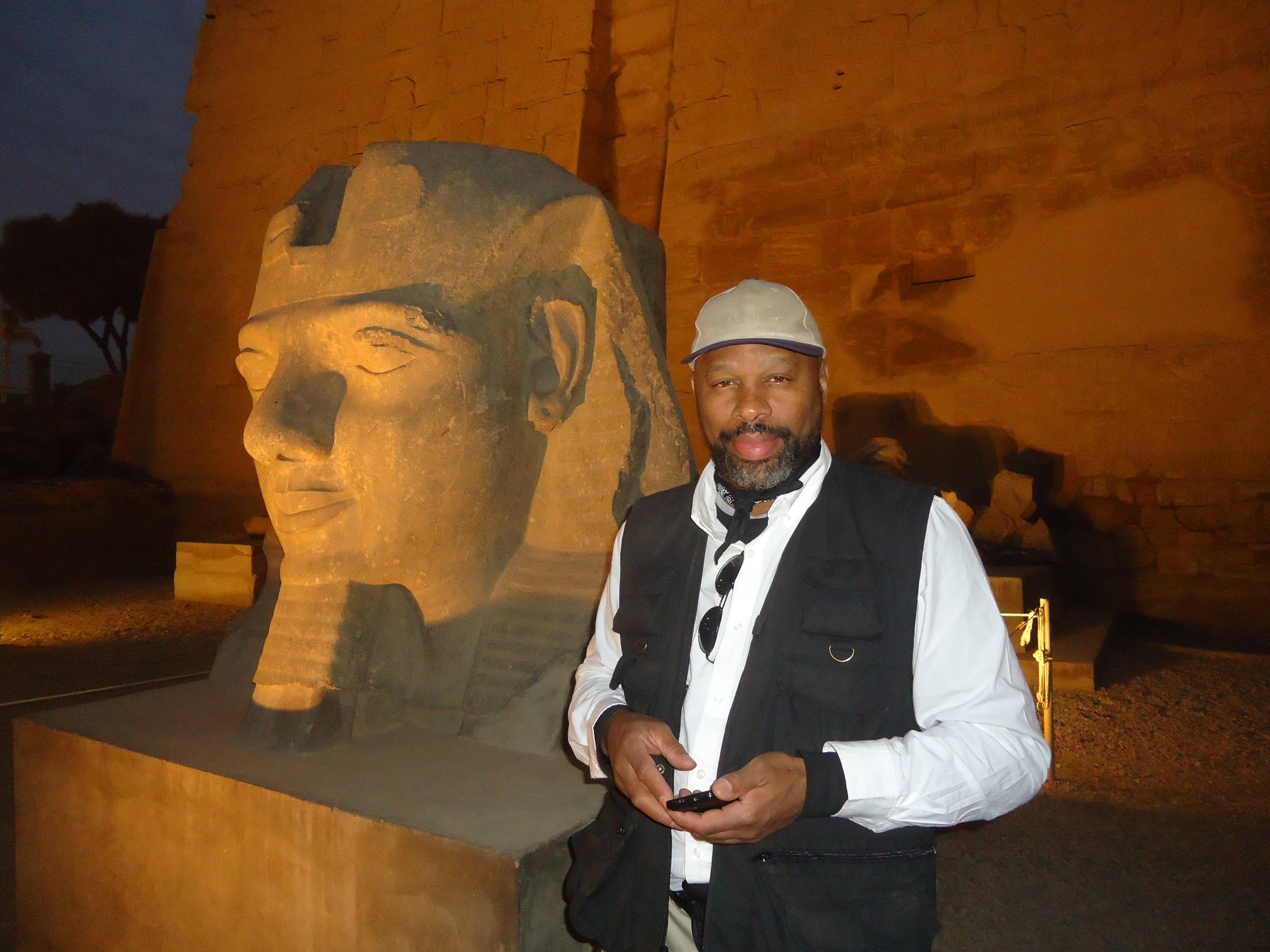An African Adventure in Egypt: Our Journey to Each Other
The author.
IN 1969, I was a first grader growing up in Philadelphia. Martin Luther King and Bobby Kennedy were both dead. And the nation was divided by race and class like never before. I can remember one morning my class was taken to the library. My attention turned to the magazines on one bookshelf. While my classmates were cracking open “Babar the Elephant” and “Dr. Seuss”, I found myself drawn to a copy of National Geographic. It was the May 1969 edition showcasing one of the Egyptian Colossus of Ramesses statues as it was being lifted to higher ground to make way for the Aswan High Dam that crosses the Nile.
The Abu Simbel Temple in Abu Simbel, Nubia, Egypt.
From then on, I could not get enough of learning about Egypt. I read and watched as much as I could about Egypt and other African countries. To add to my interests were my grandfather’s reflections on Marcus Garvey. He worked with Garvey’s Universal Negro Improvement Association.
AN EGYPTIAN DREAM
Finally, in 2016, an opportunity arose for me to visit Africa. I had both the time and money. By this time, I was also engaged to Dr. Nariman Abol Oyoun (Noora), an Egyptian. Noora lives and works in Egypt. However, we first met each other at the International House in Philadelphia. Noora made most of my in-country travel arrangements and I bought my EgyptAir and Turkish Airlines tickets.
After a grueling flight in a tight seat, I landed in Istanbul, Turkey for my connecting flight to Egypt. Several hours later, I finally landed in Cairo. After going through immigration, I quickly noticed that security was very high on the menu. Most of the people actually inside the airport terminal were passengers. Family and friends waiting to meet passengers were required to wait outside the airport.
My fiancée, Noora.
Just beyond the airport doors stood my fiancée, Noora, amidst a throng of brothers each clamoring to get my taxi fare. She popped out of the crowd like a brand new day, greeting me with a bouquet of roses. No woman had ever given me roses before! This was the first of many surprises.
Noora took me by cab to meet friends of hers for dinner. We headed to a popular restaurant in the heart of Cairo. There, I was introduced to a young woman named Lamiaa, a tour guide and junior archaeologist. I also met her mentor, Dr. Fekri Hassan, a renowned geoarchaeologist. I told Dr. Hassan about my work to promote African countries through my “Africa: Open for Business” project—a video series I was producing for my Youtube channel.
Dr. Fekri Hassan (in blue sweater) and other members of our tour group.
SIGHTS OF CAIRO
The next day, Noora and I went on a group tour hosted by Dr. Hassan and his colleague. They drove us through parts of Old Cairo, also called “Old City”. We were taken down Mui'z Street in the Fatimid Cairo area. For me, it was one wonder after another. There were ancient city walls that had stood since the Battle of Hastings and mosques, shops, and court yards. I felt like I was back in the 12th century.
A street in Old City, Cairo.
Everything was a new experience for me. My first full day started at the Egyptian Museum in Cairo, a veritable treasure trove of well-preserved artifacts reaching back to antiquity. Though our stay was brief, I saw things I’d only read about in magazines or seen on TV. There was the death mask of Tutankhamun and his royal possessions such as his chariot, throne, bed and other furnishings. The museum also housed the sarcophagi of many pharaohs. There were even household items like spoons, hair combs, and 2000-year-old curtains. Outside the museum were stone stela (ancient standing slabs of stone) and obelisks (vertical stone columns). These marked some of the greatest events in the history of the pharaonic dynasties.
GIZA
The Giza Plateau.
Our next stop was the Giza Plateau, just on the outskirts of Cairo. There are no words to describe my first impressions of Giza. I had dreamed of visiting since I was a child. As we approached, I could easily see the pyramids looming in the distance. They stood out from a great distance as if watching guard over Old Cairo and were much larger than I expected. The images I’d seen on television had truly understated their immensity.
Though on a tight schedule, I had time to climb a few levels up and have my picture taken on The Great Pyramid of Giza. As I placed my hand on one of its granite blocks, I felt, for the first time, that I had come face-to-face with a lost part of myself. It was my birthright—the legacy of my fathers since the dawn of time. I know it sounds grandiose, but living in America is a very sterile experience, especially compared to visiting a place where everyone looks like you!
As we drove around the Giza Plateau, our friend and guide Lamiaa described how it was home to a vast temple complex of shrines, tombs, and chapels. Each had been in use for more than 2000 years.
Before we had a chance to get the dust of the desert off our clothes we were off to catch a plane to the city of Aswan to see the wonders of southern Egypt. We dropped our guide off at her home, said our goodbyes, and caught our flight to Aswan that evening.
ABU SIMBEL
Noora stayed behind in Aswan as we agreed to reconnect after my visit to the Abu Simbel temple complex. This complex is located in Abu Simbel, a village in the southern desert land of Nubia, near the border with Sudan. On my flight to Abu Simbel, the plane flew over harsh, yet beautiful desert terrain. As the aircraft approached Abu Simbel, I could see the temple complex adjacent to the shores of Lake Nasser. Shortly after landing in Abu Simbel, I met a driver in the airport terminal named Rachmon, who drove me right to the temple complex. There, a tour guide shared many details about the temples with me. He reflected back to the 1960’s when the temples were moved to avoid being lost under the rising waters of the Nile and Lake Nasser.
At the Temple of Hathor and Nefertari.
My visit to Abu Simbel also included stops at the temple of Hathor and Nefertari as well as a stop at the temple of Ramesses II. My photos did no justice to these great monuments or to the wondrous carvings inscribed on them. These temples had been constructed by Pharaoh Ramesses II around 1264 BC. One was built to honor his wife Nefertari, whose likeness is carved on the outside. Nefertari’s carving was built in equal height to Ramesses’, symbolizing how her Pharaoh viewed her as an equal.
After a full day of sightseeing, my driver returned and drove me back to the airport for my flight back to Aswan. As we chatted, he shared his desire to leave Egypt and live in America. I was so impressed with what I had seen that I told him that he was better off in Egypt. He was then and I hope he is now!
ASWAN
The view from Aswan Park, overlooking the Nile River.
Reunited in Aswan, Noora and I continued on more adventures. We rode in a horse carriage and had dinner at a Nubian restaurant overlooking greater Aswan. The next morning we woke up early to take photos from the roof of our accommodation, the Sara Hotel Aswan.
Later that day, we headed to Luxor, a southern city that sits along the banks of the Nile. There, we stayed at the lovely Nefertiti Hotel. It was just a stone's throw from the Luxor and Karnak temples. We were given a first class tour of the temples by a tour guide named Mona. She is a brilliant young woman with deep knowledge of the temple complexes.
Here I am with Mona, one of my many brilliant Egyptian tour guides.
As the sun rose the next day, we went on a balloon ride over the temples that you can watch here. After an eventful landing, Noora and I were taken by another guide to the Temple of Nefertiti and later to other temples including Medinet Habu. None of these temples had escaped the ravages of time or of the early 19th-century European treasure hunters. Still, each of the sites was simply breathtaking. They are wonders of engineering and the surest guarantor of immortality for those who built them!
IMMERSION
As my Egyptian sojourn went on, Noora and I visited mosques and royal tombs in the Valley of the Kings. We sampled local cuisine, toured mountain monasteries, and shopped in the streets of Assuit and Cairo. I experienced Egyptian life as lived by ordinary Egyptians, their families, and in many cases their animals as well.
More than the stunning wonders of the Giza Plateau, the quiet dignity of the Egyptians, the understated elegance of secluded harems in Fatimid Cairo, and the love of my fiancée Noora, I found peace of mind and peace of heart—two things I have sought throughout my adult life in the U.S. and never found.
THE RETURN
In the year since my return to America, I have seen many things. I’ve watched the riots in Charlottesville, the endless Black-on-Black shootings in Chicago, the dog and pony show in Washington, and the steady parade of White police officers acquitted for shooting Black men. I’ve witnessed America’s continued self-denial about its racist past and present. I’ve seen all of the problems that come with being a second class Black citizen in a society driven by racial and economic divides.
It has now dawned on me that the American Dream, is just not for me. Instead, I propose to pursue the African Dreamat some point in the future!
May I see you there as well.
Enjoyed reading about Muhammad's visit to Egypt? Watch the first video of his ten-part "African Adventure: Egypt" series documenting his trip below. Experience the grandeur of Egypt through Muhammad's eyes.










